|
Sèvres: The Legendary Porcelain of France
By Robert Reed
Posted January 2013
Historically, some of the world's finest porcelain came from a factory established in 18th century France known simply as Sèvres. Almost from the start, Sèvres had talented artists, efficient management and the support of country's royalty. As a result, the operation produced wonderful designs framed in amazingly rich colorings. In a relatively small amount of time, artful porcelain crafted at Sèvres achieved worldwide status.
More than half a century ago, antique author and historian Harold Lewis Bond noted in An Encyclopedia of Antiques, "There is no continental porcelain better known by name to everyone or more desirable for the collector than the French porcelain of Sèvres."
Most accounts indicate that the operation that would be Sèvres first began around 1745 under the direction of Charles Adam in Vincennes, France. However, apparently there was some experimental work with soft paste porcelain at that site several years earlier.
The firm struggled in the early years but did graduate from a basic plain white product to the use of a dark underglaze of cobalt blue, termed bleu de rol by the French. In time, it was said that the bleu de rol was rarely used without gold traces within the patterns over the overall network design.
By the 1750s, the firm had further developed their basic porcelain to make it suitable for figures and statuettes as well as more elaborate decorative vases. Moreover, the firm established even closer ties with the French government, which in turn heavily controlled the marketplace.
By the time the factory was moved from Vincennes to Sèvres in the middle 1750s, it was already known as the Royal Manufactory and was clearly in the direct favor of King Louis XV. At the new site, located between Paris and Versailles, production expanded further to include table services, flower pots, trays and pomade jars, along with the existing line.
As a formal bow to the king, Sèvres introduced Louis XV's own monogram; two L-letters were shown crossed as their official mark. Eventually, artists at the site would develop an exquisite pink color and name it “Rose Pompadour” in honor of still another royal and loyal supporter, Madame de Pompadour (Jeanne Antoinette Poisson1, the Marquise de Pompadour, 1721-1764). Madame Pompadour almost single-handedly established Sèvres porcelain as the decoration of choice throughout Europe. (The pompadour hairstyle was also named after her.)
Interestingly, the English later mispronounced this famous ware and called it “rose du Barry” rather than rose Pompadour, but it “rose” in popularity among the well-to-do there anyway.
Besides the multiple letter L as marks, Sèvres also began using letters of the alphabet during the 1750s to indicate the year in which the pieces were made. In the years that followed, the markings were extended to include double letters such as AA and BB, to denote various time periods. The corresponding letter was placed immediately between the two script Ls and was changed annually.
Moreover, the evolution of Sèvres remarkable use of color on their fine wares continued. Painted decoration, classified as ground color, grew more and more beautiful. Beside the cobalt blue, selections also included a dark mottled blue (gros bleau), turquoise (bleu celest), a sort of canary yellow, and what would eventually be called an apple green.
Added to the richly colored grounds were domestic scenes, birds and flowers. Sèvres also began adding extensive jeweled decorations to their gold gilding. The overall result was a breath-taking product for potential customers.
The problem in the late 18th century, however, was Sèvres porcelain was literally fit for a king and the rest of the royal court. As elegant as it was, it was far too costly at the time for anyone but the wealthiest families in France and other parts of Europe. Even Dresden and Oriental wares were comparatively much less expensive during that era.
By the late 1760s, the factory began a very, very gradual move toward replacing soft paste porcelain with a hard-paste porcelain, which seemed more manageable for crafting and decorating. The newer hard paste was identified as Porcelaine Royale to distinguish it from the early soft paste Porcelaine de France. Some soft paste production continued, however, until the onset of the 19th century.
It is a historical fact that the Sèvres operation began as a totally private enterprise and gradually came more and more under the influence, if not outright ownership, of Louis XV and later, Louis XVI. Things clearly changed for Sèvres during the French Revolution. Suddenly, it was no longer fashionable or even safe to use royal letters of the king on fine porcelain. Specifically, on July 17, 1793, Royal Sèvres ended, and the new republic influence began.
Early in the 1790s, pieces were marked “RF” for the Republic of France. At the dawn of the 1800s, markings at Sèvres began to include date signs such as oz, which stood for the French word onze for the number (or year) of eleven. Thus oz, for example, would date to actual manufacture in 1811.
Things changed dramatically at Sèvres as a result of the change in French government. In the early 1800s, the factory was put under the direction of Alexandre Brongniart who brought renewed efforts to the porcelain production process. Brongniart "…brought a new vibrancy to French porcelain at the beginning of the Restoration," noted experts at Sotheby’s auction center, "by continually searching for new designs, new techniques, new colors, and new sources and new artists."
Under Brongniart, the factory ceased the use of soft-paste porcelain, which had lingered in production, and went entirely to hard-paste porcelain. High among the successful products of the Sèvres factory during the term of Director Brongniart were detailed vases and full services. The best of these combined strikingly colored grounds with superbly controlled gilt borders, which framed topographical views.
Sèvres continued production of fine porcelain pieces throughout the 19th century, often incorporating lavishing coloring on delicate designs. They were frequently framed in the gilt-bronze tradition, which had brought their long-lasting fame.
Today, original Sèvres porcelain is highly prized and commands leading prices at major auctions and shows. In addition, much of the 19th century Sèvres -style porcelain, although lacking in the direct connection of the French legend, is also prized.
____________________
1Poisson in French means fish.
Photo credits—
Clodion vase: User: Loicwood.
Dinnerware: Myrabella, Wikimedia Commons, CC-BY-SA-3.0.
Chinoiserie vases: Catherine Delors, http://blog.catherinedelors.com/french-porcelain-for-english-palaces-at-the-queens-gallery.
Madame Pompadour: 1992: purchased by Château de Versailles from Didier Aaron Ltd., London; oil on canvas by Charles-André van Loo (1705-1765) titled, The Marquise de Pompadour as a Gardener (1722–1764), ca. 1754-1755.
Rose Pompadour: www.liveauctioneers.com, sold for Neal Auction Co., April 14, 2007.
|
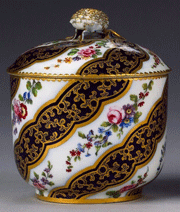
Sèvres sugar pot Bouret shape, ca. 1770.
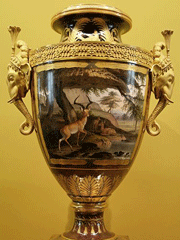
One of a pair of Clodion vases given by Louis XVIII to his brother, the future King Charles X, currently in the Louvre in Paris; hard-paste porcelain and gilt bronze, 1817.
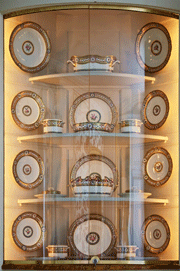
Sèvres porcelain dinnerware ordered for the Queen Marie-Antoinette in 1784, in the Palace of Versailles.
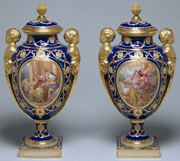
Sèvres porcelain chinoiserie vases first purchased by Marie-Antoinette in 1779, in the Queen’s Gallery in London.
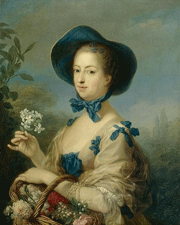
Favorite of King Louis XV, Jeanne Antoinette Poisson, the Marquise de Pompadour, aka Madame de Pompadour; Rose Pompadour was so named for Madame Pompadour (Antoinette Poisson, the Marquise de Pompadour), the favorite of King Louis XV.
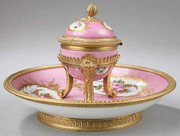
A Rose Pompadour Encrier, late 19th/early 20th c., with gilt trim, sold for $650.
|